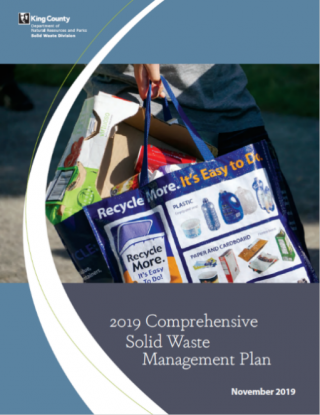King County, Washington, Helps Municipalities Account for Climate Change in Local Government Services

King County, Washington, used available national and regional climate risk information to consider climate-related impacts and plan adaptive actions for many of its municipal services. The County is projected to experience climate change impacts such as warming temperatures, rising seas, increasing flooding risk, decreasing mountain snowpack, more frequent drought conditions in the summer, and acidifying marine waters. These impacts can have direct effects on municipal services, including those related to waste storage, transportation, and management operations.
Accordingly, the County accounts for climate change in its service planning activities. For example, King County’s “2019 Comprehensive Solid Waste Management Plan” anticipates and plans for climate change impacts related to the county’s waste management services. The County includes adaptation as one of the three primary methods of reducing climate change impacts by “…modifying facilities and operations to address the effects of climate change.” Examples include designing facilities for more severe weather systems (e.g., roofs designed for greater snow loads), using more drought-tolerant plants in facility landscapes, and identifying alternate transportation routes to avoid areas where there may be an increase in seasonal flooding.”
It is worth noting that King County addresses climate vulnerabilities related to a broad range of community services – beyond waste management services -- such as wastewater, stormwater, emergency management, public health, roads, flood risk reduction, and salmon recovery. The County’s efforts are summarized in the King County Strategic Climate Action Plan(updated 2020) and its climate change webpage tracks resources and efforts to address climate adaptation across county services.
|
How Did They Do It? |
Applicable EPA Tools |
|---|---|
|
Identified climate risks
|
A number of tools exist to help communities identify potential climate impacts, including the U.S. Climate Resilience Toolkit, Steps to Resilience: National Oceanic and Atmospheric Association: National Climatic Data Center NOAA’s Global Analysis * Note: These are not EPA Tools |
|
Evaluated and developed a plan to address climate change impacts strategically across the county and municipal services
|
To help assess your climate risk and vulnerabilities, investigate options, and plan to improve climate resiliency and adaptation Planning for Climate Change Adaptation U.S. Climate Resilience Toolkit *Note: Not an EPA Tool |
|
Considered the lifecycle of solid waste management activities to identify three adaptation steps to make solid waste management more resilient to climate change:
|
While EPA does not have climate change adaptation tools specifically developed for waste management activities, the following webpages and tools can help account for potential impacts at waste facilities and operations: Waste Management Planning to Mitigate the Impact of Climate Change - Climate change is expected to produce more frequent and powerful natural disasters, which will increase the amount of disaster-related waste generated. Communities can adapt to these disasters and increase their resiliency by preparing for these disasters through pre-incident planning. Planning can expedite the removal of waste during and after an incident, which can reduce dangers of fire, personal injury and disease vectors and identify waste management opportunities and strategies. Climate adaptation efforts in King County include protecting waste facilities from more severe weather systems and increased flooding. The following tools and resources can provide insight into flood vulnerability and stormwater management: Enhancing Sustainable Communities With Green Infrastructure Guide - The Green Infrastructure Guide helps communities plan and design green infrastructure for multiple environmental, health, social, and economic benefits. Stormwater Calculator with Climate Assessment Tool – Desktop application that estimates the annual amount of rainwater and frequency of runoff from a specific site anywhere in the United States. The calculator includes future climate vulnerability scenarios. Storm Surge Inundation and Hurricane Strike Frequency Map – This tool includes maps of FEMA 100- and 500-year flood plains. |
Similar Cases and More Information:
To see how a Superfund site responded to disaster by rebuilding facilities to account for expected climate changes, see American Cyanamid Superfund Site Reduces Climate Exposure. Augusta, Georgia; Barre City, Vermont; and San Francisco, CA used EPA’s Analysis of Brownfield Cleanup Alternatives Checklist to better understand the climate vulnerability of a redevelopment project on a brownfield site.
- American Cyanamid Superfund Site Reduces Climate Exposure
- Augusta, Georgia Brownfield Cleanup
- Barre City, Vermont Accounts for Climate Change within a Brownfield Redevelopment Plan
- San Francisco Cleans Up India Basin Waterfront Brownfield Site as Part of Greenspace Development Effort
To see how four counties are preparing to manage increased debris from more severe weather systems, see
References:
- Climate Change Impacts and Adaptations in Washington State: Technical Summary for Decision Makers (Climate Impacts Group, University of Washington)
- Global Analysis: 2013 (NOAA)
- Preparing for a Changing Climate: Washington’s Integrated Climate Response Strategy (Washington Department of Ecology)
- Preparing for Climate Change: A Guidebook for Local, Regional and State Governments (Climate Impacts Group, University of Washington)
- Responding to the Climate Change Challenge: Focus on Impacts of Climate Change in Washington State (Washington Department of Ecology)
- King County Strategic Climate Action Plan
- King County Comprehensive Solid Waste Management Plan (especially, “Climate Change”, page 2-22 and Policy ES-4)
- King County Strategic Climate Action Plan (2020)
